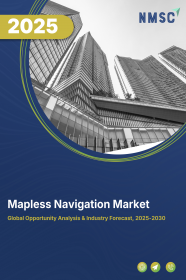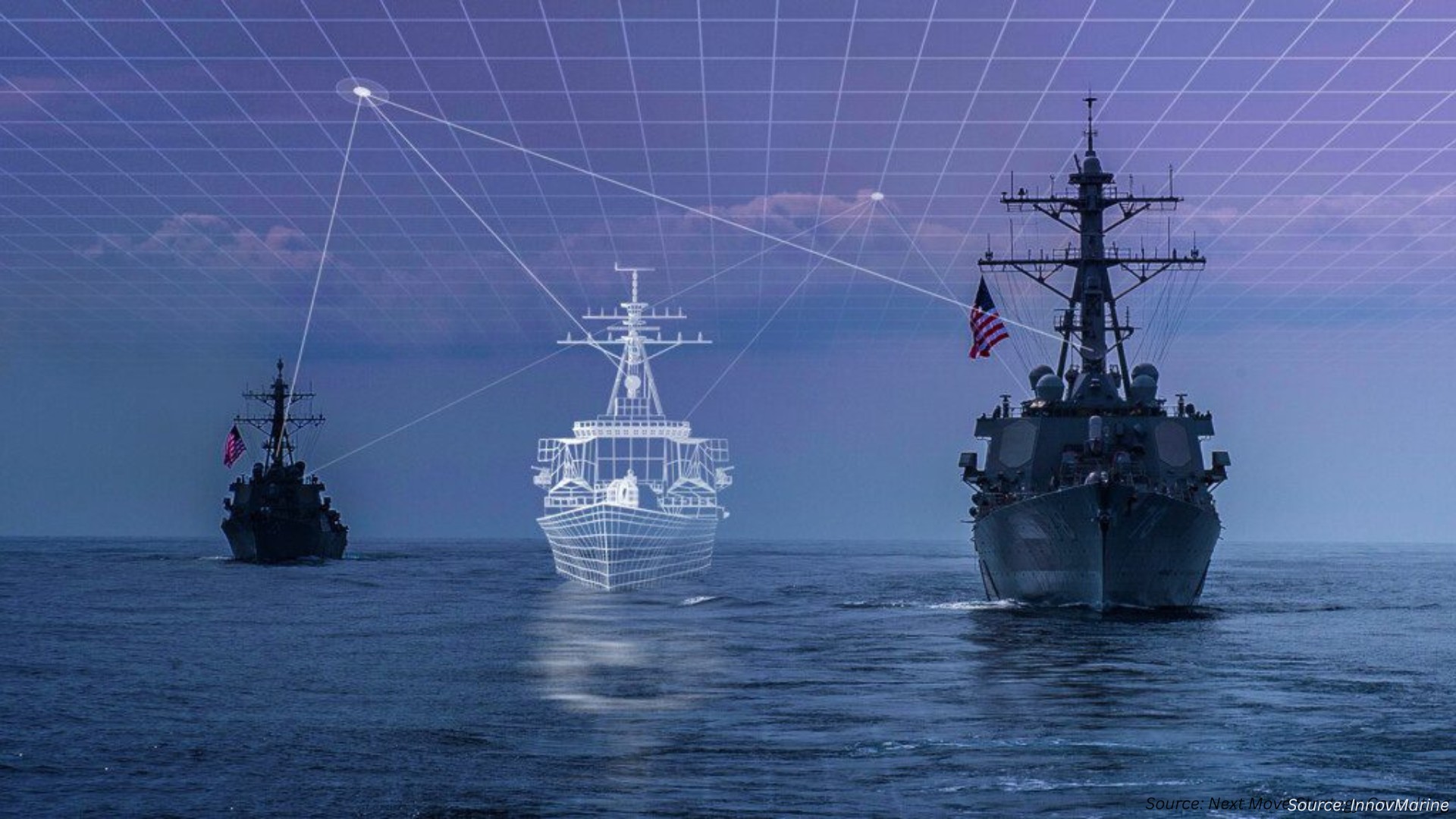
Mapless Navigation Market by Component (Hardware, Software, and Services), Technology (Sensor-Based Navigation, Machine Learning-Based Navigation, and Computer Vision-Based Navigation, and Others), and by End-User (Automotive, Robotics, Aerospace & Defence, UAVs, Logistics & Transportation, and Others)- Global Opportunity Analysis and Industry Forecast 2025-2030
Mapless Navigation Market Overview
The Mapless Navigation Market size was valued at USD XXX million in 2024 and is predicted to reach USD XXX million by 2030 with a CAGR of XY% from 2025-2030.
The mapless navigation market refers to the industry focused on the development and deployment of navigation systems that enable vehicles, robots, or other autonomous machines to navigate without relying on traditional, preloaded maps. It relies on using various sensors, such as cameras, lidar, and inertial measurement units (IMUs), to detect and interpret the surrounding environment and generate a map of it in real time.
It provides various features such as turn-by-turn directions, traffic updates, voice commands, and alternate routes. It also allows users to search for points of interest such as restaurants, gas stations, and other landmarks. Mapless navigation is considered more flexible and adaptable than traditional map-based navigation systems, as it handles unexpected changes in the environment, such as obstacles or unexpected terrain features.
Market Dynamics and Trends
The growing adoption of autonomous vehicles worldwide is driving the growth of the mapless navigation market, as these vehicles rely on real-time sensory data and advanced technologies to navigate without the need for traditional maps. According to a report by Next Move Strategy Consulting, the global autonomous vehicle market was valued at USD 104.87 billion in 2022 and is projected to reach USD 614.88 billion by 2030. As Avs require highly advanced navigation systems that operate without relying on pre-mapped data is fostering the growth of the market.
Moreover, technological advancements, particularly in artificial intelligence, machine learning, and sensor integration, are driving the growth of the mapless navigation industry as these innovations allow systems to operate without traditional maps, improving real-time decision-making and efficiency.
For instance, in January 2023, Pony.ai partnered with Horizon Robotics to develop a mapless navigation system for autonomous vehicles navigation. This collaboration utilizes advanced AI navigation and sensor technologies to enable vehicles to navigate without traditional maps, improving real-time decision-making.
Furthermore, the growth of the aerospace and defense sector is driving the mapless navigation industry as increasing adoption of autonomous systems, drones, and unmanned aerial vehicles (UAVs) requires advanced navigation technologies. These systems rely on real-time sensory data processing and precise navigation without traditional maps, fueling demand for mapless navigation solutions.
According to PwC’s global aerospace and defense, annual industry performance and outlook, in 2023, the global aerospace and defense industry achieved record revenue of USD 829 billion, marking an 11% increase compared to 2022. This growth drives the market by fostering demand for advanced technologies to enable precise, real-time navigation in autonomous systems and UAVs.
However, high costs associated with integrating advanced technologies, such as sensors and algorithms, restraint the growth of the market, especially for small and mid-sized businesses.
On the contrary, the introduction of LiDAR technology that uses laser beams to create detailed 3D maps of the environment coupled with the integration of 5G will provide more accurate real-time location data and is expected to create ample opportunities in the growth of the mapless navigation industry in the coming years.
Market Segmentations and Scope of the Study
The mapless navigation market report is segmented on the basis of component, technology, end-user, and region. On the basis of component, the market is classified into hardware, software, and services. On the basis of technology, the market is segmented into sensor-based navigation, machine learning-based navigation, and computer vision-based navigation, and others. Based on end-user, the market is divided into automotive, robotics, aerospace & defence, UAVs, logistics & transportation, and others. Regional breakdown and analysis of each of the aforesaid segments include regions comprising of North America, Europe, Asia-Pacific, and RoW.
Geographical Analysis
North America holds the dominant in the mapless navigation market share and is expected to continue its dominance during the forecast period due to the growing adoption of autonomous vehicles in this region. As per the latest report from the National Association of Insurance Commissioners, the U.S. one of the largest adopters of autonomous vehicles in the world, with an estimation of 3.5 autonomous vehicles in the U.S. Road by 2025 and 4.5 million vehicles by 2030. The growth in autonomous vehicles is drive the expansion of the market, supported by increasing technological advancements and adoption across the region.
Also, the rapid growth of the aviation industry in the region is further is driving the growth of the industry by increasing the mapless navigation market demand for drones and UAVs in applications such as logistics, surveillance, and transportation. These systems require navigation technologies that adapt seamlessly to dynamic environments without relying on traditional maps, ensuring operational efficiency and precision.
According to the recent report published by the Airlines for America, the commercial aviation industry in the U.S. reached USD 1.25 trillion, carrying 2.3 million passengers and 66,000 tons of cargo in 2022. With such rapid growth in the aerospace industry in this region, the demand for advanced navigation solution to improve safety and efficiency in various environmental conditions is poised to rise, further driving the adoption of mapless navigation technology.
On the other hand, Asia Pacific is expected to show steady growth in the mapless navigation market, driven by the growing automotive industries in this region. According to the International Trade Administration, China is the largest vehicle manufacturing country in the world, with over 25 million vehicles sold in 2020. Domestic production is expected to reach 35 million vehicles by 2025. As a result, the increasing number of vehicles equipped with mapless navigation systems is anticipated to fuel market growth in Asia Pacific.
Moreover, increasing investment in the development of military & defense sector including the adoption of advanced vehicles and electronics with mapless navigation for accurate and real-time navigation in remote areas is further driving the mapless navigation market growth in this region. According to the World Bank, investment in military and defence sector is growing at a significant rate in this region, with China's investment reaching USD 298 billion, while India’s reached USD 81 billion in 2022.
Competitive Landscape
Various key players operating in the mapless navigation industry include Mapless AI, Inc., Imagry, Driveblocks, WeRide, Pony.ai, WayRay AG, Neusoft Corporation, ARway Corp, Treedis, Navigine, Furuno Electric Co., Ltd, U-blox, Artisense, IndoorAtlas, Situm Technologies, and others. These companies are adopting various strategies such as product launches to remain dominant in the mapless navigation industry.
For instance, in December 2022, Driveblocks launched a mapless autonomy platform to provide automation solutions to the commercial vehicle industry. The navigation system provides object recognition, environment perception, sensor fusion, and trajectory planning in vehicles.
Moreover, in March 2022, Ottonomy.IO launched high-information navigation mapping for autonomous robots. Through this launch, the company aims to provide real-time navigation for robots in multiple consumer environments including airports, retail spaces, and campuses.
Key Benefits
-
The report provides quantitative analysis and estimations of the mapless navigation market from 2025 to 2030, which assists in identifying the prevailing market opportunities.
-
The study comprises a deep-dive analysis of the current and future mapless navigation market trends to depict prevalent investment pockets in the industry.
-
Information related to key drivers, restraints, and opportunities and their impact on the mapless navigation market is provided in the report.
-
Competitive analysis of the players, along with their market share is provided in the report.
-
SWOT analysis and Porters Five Forces model is elaborated in the study.
-
Value chain analysis in the market study provides a clear picture of roles of stakeholders.
Mapless Navigation Market Key Segments
By Component
-
Hardware
-
Software
-
Services
By Technology
-
Sensor-Based Navigation
-
Machine Learning-Based Navigation
-
Computer Vision-Based Navigation
-
Others
By End-User
-
Automotive
-
Robotics
-
Aerospace & Defence
-
UAVs
-
Logistics & Transportation
-
Others
By Region
-
North America
-
The U.S.
-
Canada
-
Mexico
-
-
Europe
-
The UK
-
Germany
-
France
-
Italy
-
Spain
-
Denmark
-
Netherlands
-
Finland
-
Sweden
-
Norway
-
Russia
-
Rest of Europe
-
-
Asia Pacific
-
China
-
Japan
-
India
-
South Korea
-
Australia
-
Indonesia
-
Singapore
-
Taiwan
-
Thailand
-
Rest of Asia Pacific
-
-
RoW
-
Latin America
-
Middle East
-
Africa
-
Key Players
-
Mapless AI, Inc.
-
Imagry
-
Driveblocks
-
WeRide
-
Pony.ai
-
WayRay AG
-
Neusoft Corporation
-
ARway Corp
-
Treedis
-
Navigine
-
Furuno Electric Co., Ltd
-
U-blox
-
Artisense
-
IndoorAtlas
-
Situm Technologies
REPORT SCOPE AND SEGMENTATION:
|
Parameters |
Details |
|
Market Size in 2024 |
USD XXX Million |
|
Revenue Forecast in 2030 |
USD XXX Million |
|
Growth Rate |
CAGR of XY% from 2025 to 2030 |
|
Analysis Period |
2024–2030 |
|
Base Year Considered |
2024 |
|
Forecast Period |
2025–2030 |
|
Market Size Estimation |
Million (USD) |
|
Growth Factors |
|
|
Countries Covered |
28 |
|
Companies Profiled |
15 |
|
Market Share |
Available for 10 companies |
|
Customization Scope |
Free customization (equivalent up to 80 working hours of analysts) after purchase. Addition or alteration to country, regional, and segment scope. |
|
Pricing and Purchase Options |
Avail customized purchase options to meet your exact research needs. |




















 Speak to Our Analyst
Speak to Our Analyst
























